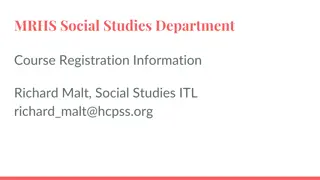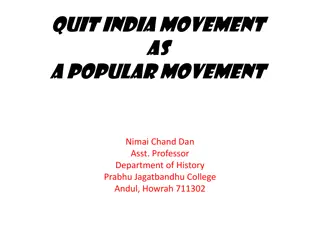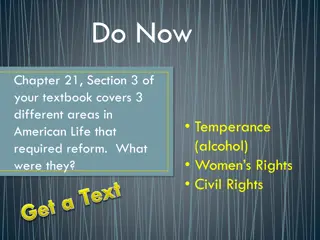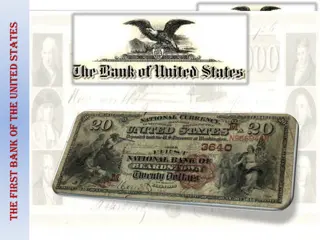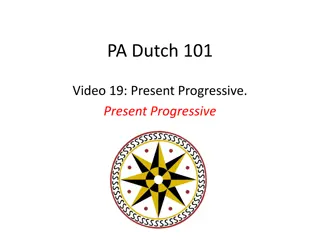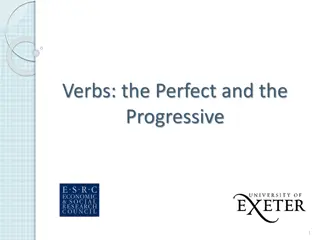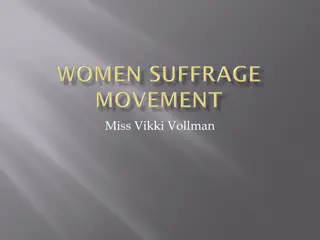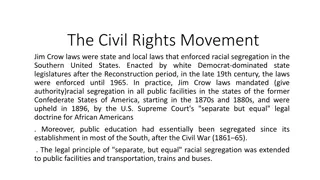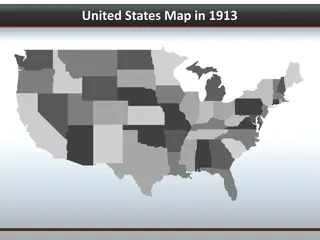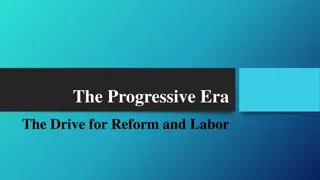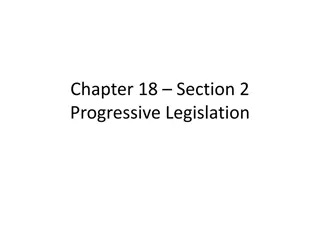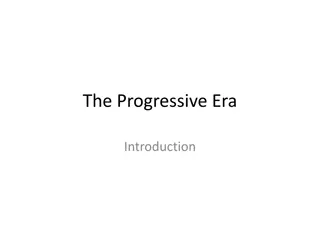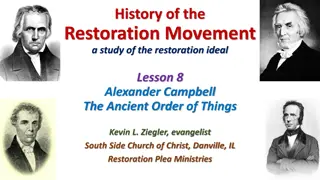Understanding the Progressive Movement in United States History II
Explore the Progressive Movement in US History II Module 5, focusing on major movements, politics, muckrakers' role, reform leaders, women's rights, civil rights, and progressive policies under Roosevelt, Taft, and Wilson. Learn about grassroots Progressivism, social justice reformers, the Triangle Shirtwaist Factory Fire, and radical movements. Dive into the origins of the progressive spirit in America, muckrakers like Riis, Sinclair, and Tarbell, and major features of Progressivism emphasizing social, political, and economic reforms.
Download Presentation

Please find below an Image/Link to download the presentation.
The content on the website is provided AS IS for your information and personal use only. It may not be sold, licensed, or shared on other websites without obtaining consent from the author. Download presentation by click this link. If you encounter any issues during the download, it is possible that the publisher has removed the file from their server.
E N D
Presentation Transcript
United States History II Module 5: The Progressive Movement
Module Learning Outcomes Describe the major movements and politics of the Progressive Era 5.1: Describe the role that muckrakers and reform leaders played in catalyzing the Progressive Era 5.2: Describe how the progressive movement influenced women s rights and the early civil rights movement 5.3: Explain progressive policies enacted under the presidencies of Theodore Roosevelt, William Taft, and Woodrow Wilson 5.4: Historical Hack: Identify and analyze bias and sensationalism in newspaper articles
Learning Outcomes: The Progressive Movement 5.1: Describe the role that muckrakers and reform leaders played in catalyzing the Progressive Era 5.1.1: Describe the role that muckrakers played in catalyzing the Progressive Era 5.1.2: Explain the main features of Progressivism 5.1.3: Identify specific examples of grassroots Progressivism relating to the spread of democracy and efficiency in government 5.1.4: Explain the significance of social justice reformers like Jane Addams and Carrie Nation, in enacting positive social change in American Society in the early 1990s 5.1.5: Explain the significance of the Triangle Shirtwaist Factory Fire 5.1.6: Describe the more radical movements associated with the Progressive Era as well as the growth of socialism
Introduction to The Progressive Movement What you ll learn to do: describe the role that muckrakers and reform leaders played in catalyzing the Progressive Era
Muckrakers Muckrakers are journalists who exposed corruption in society. Yellow Journalists were focused on exaggerating news stories in order to sell papers, while muckrakers wanted to expose problems and urge the government to take action. Significant Muckrakers Include: Jacob Riis focused on poverty and the urban poor in How the Other Half Lives Upton Sinclair focused on the meatpacking industry and food production in The Jungle Ida Tarbell focused on monopolies in Wealth Against Commonwealth
Major Features of Progressivism Major Features of Progressivism Fixing problems of the Gilded Age Shifting role of the government to watch out for the welfare of the General Public Social, Political, and economic reform The Social Gospel Gospel means good news This is the good news for Society, as brought forth by Protestant Christians that people should take care of those less fortunate.
Progressivism at the Grassroots Level A major goal of progressivism was political reform, to put more power in the people s hands Political Reforms included: o Direct Primary: Citizens voting directly for a candidate o Initiative: Citizens initiate, or propose, a bill to be placed on a ballot to be voted by the general public o Referendum: Instead of representatives voting on passing a bill, citizens vote to decide if it becomes a law o Recall: Citizens vote to remove an elected official from office
Social Justice and Social Reform The Moral Dilemma of Alcohol o Temperance/Prohibition was a major social reform, centered both on health and family issues o Carrie Nation and the Women s Christian Temperance Union were major advocates for this, paving the way to the 18th Amendment Jane Addams and the Birth of Social Work o Settlement Houses provided immigrants and the urban poor a variety of services o Addams Settlement House was the Hull House in Chicago
More Social Justice and Social Reform Child Labor o National Child Labor Committee was formed in 1904 to investigate and ban child labor Triangle Shirtwaist Factory Fire o March 25, 1911; resulted in 146 deaths caused by a lack of safety measures o Served as a catalyst to the Progressive movement, urging government and business leaders to take action to protect workers
Radical Progressive Movements Radicalism: Belief that reform was pointless and that America needed a complete revolution Socialism argued for equality in society and the end of the disparity between rich and poor Significant Radical Movements include: o Socialist Party of America (SPA) o Industrial Workers of the World (IWW) Eugene Debs was a significant socialist leader who ran for president twice.
Practice Question 1 Journalists who exposed issues in American society during the late 1800s and early 1900s were referred to as a. Yellow Journalists b. Muckrakers c. Carpetbaggers d. Wobblies
Movements for Women and African Americans
Learning Outcomes: Movements for Women and African Americans 5.2: Describe how the progressive movement influenced women s rights and early civil rights movements 5.2.1: Describe the origins and growth of the women s rights movement leading to the passage of the 19thamendment 5.2.2: Describe discriminatory policies towards Black Americans during the Jim Crow era, including the challenges of disenfranchisement and segregation 5.2.3: Compare and contrast the viewpoints of African-American reformers in the Early Civil Rights Movement, including Booker T. Washington and W.E.B. Dubois
Introduction to Movements for Women and African Americans What you ll learn to do: describe how the progressive movement influenced the struggle for women s rights and the early civil rights movement
The Womens Rights Movement and the 19th Amendment Suffrage=right to vote The goal for women gaining the right to vote was set in the Declaration of Sentiments declared at the Seneca Falls Convention in 1848. Major leaders in the women s suffrage movement include o Elizabeth Cady Stanton o Susan B. Anthony o Alice Paul 19thAmendment- Passed in 1920 and granted women the right to vote
A Segregated America The Era of Jim Crow in the years following reconstruction challenged the rights African Americans received under the 14thand 15thamendments Efforts of disenfranchisement (restricting voting rights) o Poll Tax- paying a fee to vote o Unjustifiable charging of crimes o Literacy Test- proving that you were literate enough to vote The Supreme Court Case Plessy vs. Ferguson established the doctrine of Separate But Equal legalizing segregation in the United States.
Historical Hack: Separate But Equal? Analyze this political cartoon using HAPPY Historical Context- What is going on in America at the time? Audience- Who is this cartoon intended for? (Be more specific than people or Americans . Purpose- Why was this cartoon created? Point of View- What is the perspective of the author of this cartoon? Why- What is the significance of the event this cartoon is depicting?
Leaders Emerge in the Early Civil Rights Movement Booker T. Washington o Believed in slow progress for African Americans, through job training and education o Delivered the Atlanta Compromise speech in 1895, urging African Americans to get along with the white community W.E.B. Dubois o Believed in immediate equality for African Americans and the rights guaranteed by the 13th, 14th, and 15thamendments o Founder of the NAACP in 1909 (National Association for the Advancement of Colored People
Practice Question Which of the following was a method used to disenfranchise African Americans by requiring them to prove that they were competent enough to vote? A. Poll Tax B. Literacy Test C. Sharecropping D. Unjustifiable charging of crimes
Learning Outcomes: Progressive Era Presidents 5.3: Explain progressive policies enacted under the presidencies of Theodore Roosevelt, William Taft, and Woodrow Wilson 5.3.1: Explain the key features of Theodore Roosevelt s Square Deal, including his regulation of business practices 5.3.2: Explain the effect that conservation efforts had on preserving the natural environment of the United States 5.3.3: Explain the key features of William Howard Taft s progressive agenda and how that contrasted with Roosevelt s 5.3.4: Summarize Wilson s presidency, including the main pieces of legislation coming from his New Freedom agenda
Introduction to Progressive Era Presidents What you ll learn to do: explain progressive policies enacted under the presidencies of Theodore Roosevelt, William Taft, and Woodrow Wilson
Roosevelt and the Square Deal o Roosevelt s 1904 Square Deal focused on the Three C s : o Control of Corporations o Consumer Protection o Conservation of Natural Resources
The Square Deal: Control of Corporations Control of Corporations o Roosevelt earned a reputation as a Trust Buster , breaking up monopolies o Created the Department of Commerce and Labor in 1903 o Urged the Department of Justice to resume prosecutions under Sherman Antitrust Act of 1890. o Signed the Hepburn Act in 1906, allowing the Interstate Commerce Commission to regulate practices and prices for the railroad
The Square Deal and Consumer Protection Consumer Protection o Investigations by muckrakers urged Roosevelt to protect consumers o Meat Inspection Act of 1906- established procedure for government inspection of meat o Pure Food and Drug Act of 1906- required labels on food products
Environmentalism Conservation of Natural Resources o Two competing ideals o Preservation- setting aside lands for aesthetic and spiritual value to get in touch with Mother Earth (John Muir) o Conservation- emphasizing efficient use of available resources (Gifford Pinchot- father of American Forestry o Foundation of National Park Service to conserve scenery and wildlife for enjoyment by the public.
The Taft Presidency Taft s Background o Taft was a close friend of Teddy Roosevelt and served as his Secretary of War from 1904 to 1908 o Taft s ultimate goal was to be a Supreme Court Justice o Taft and Roosevelt s presidency became strained during Taft s first term o Calling Taft a fathead , he decided to run against Roosevelt in the 1912 election
The Election of 1912 Election of 1912 o Major Candidates o William Howard Taft- Incumbent; Republican o Woodrow Wilson- Democrat o Theodore Roosevelt- (Formerly Republican but founded his own party, the Progressive or Bull Moose Party, to run against Taft o Wilson won the 1912 election due to votes being split between Taft and Roosevelt, since their ideologies and platforms were similar.
Wilsons New Freedom Major Components of Wilson s New Freedom Agenda, focused on progressive ideals o Federal Reserve Act- regulated banking industry by creating twelve regional banks who distributed money to other banks across the country o Clayton Antitrust Act- regulated mergers and price discrimination and protected labor actions
Practice Question 2 The Election of 1912 resulted in which candidate being victorious? A. Theodore Roosevelt B. Woodrow Wilson C. William Howard Taft D. Eugene Debs
Historical Hack: Bias & Sensationalism in Primary Source Media
Learning Outcomes: Bias & Sensationalism in Primary Source Media 5.4: Identify and analyze bias and sensationalism in newspaper articles 5.4.1: Examine how point of view and bias influence sources 5.4.2: Recognize sensationalist reporting techniques and how they are used to influence opinion
Historical Hack: Bias & Sensationalism in Primary Source Media What you ll learn to do: identify and analyze bias and sensationalism in newspaper articles
Class Activity: Bias & Sensationalism in Primary Source Media Think about these goals of sensationalist reporting and consider how these apply to today s world. Then reflect on the following questions. Where can you see these tactics being used in today s media? Do outlets like the internet and social media make it easier to create outrage or appeal to fear? Find a news article online and ask yourself: Is this sensationalist reporting and what is the goal? What is this story/headline/video/article trying to make me feel, do, or think?
Class Activity: Bias & Sensationalism in Primary Source Media (cont.) Is it harder for news outlets to get away with sensationalist or biased reporting nowadays because the internet makes it easier to fact-check information? Or is it easier because the internet is so full of biased or inaccurate information that fact- checking has become harder for the average citizen?
Quick Review Progressive Reforms were centered in three areas and the goal of the Progressive Movement was for the government to take more responsibility for maintaining the welfare of the general public. Political Social Economic 19thAmendment- Women s Suffrage Jane Addams and the Hull House Issues in society exposed by Muckrakers Initiative, Referendum, Recall Prohibition Pure Food and Drug Act; Meat Inspection Act Radicalism and Rise of Socialism Early African-American Civil Rights Movement Trust-Busting/Regulating Election of 1912 resulted in Wilson s victory Conservationism Federal Reserve Act





